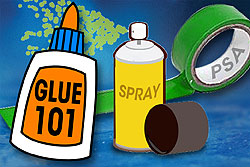People often find that their glued pieces shift in the
firing. Sometimes dramatically. This can
be from placement or boiling of the glue.
Almost all commonly available glues evaporate well below
the “sticky” range of glass.
The boiling points of some of the popular glues:
PVA
(also known as: wood glue, white glue, carpenter's glue, school
glue, Elmer's glue in the US, or PVA
glue)
Boiling
point: 112°C (234°F)
Super glue (and other cyanoacrylate
glues)
boiling
point 54-56°C (129-133°F)
Lacquer (hair spray)
Boiling
point: 185 to 189°C (365 to 372°F)
CMC (carboxymethyl cellulose includes wallpaper
paste, vitragel and most fusing glues)
boiling
point: 260–270°C (500–518°F)
melts at
274°C
Aloe vera gel
ignition point: ca. 232°C
therefore, its boiling point is lower.
This shows the popular glues used in kilnforming are not
effective above 300°C and many with much lower boiling points. This means that glues only hold glass in
place when cold. Glues may be useful in getting items with many pieces into the
kiln, but they will not hold them in place until the glass becomes sticky. The glass, in general, needs to be at or
above the slumping temperature to begin to stick together.
If glue doesn’t work, what can I do?
Other means than glues are required to support the
moveable items until the glass become sticky at around 620°C (about 700°C for
float glass).
If placing frit supports is not possible without showing, such as in a tack fuse,
you can use mechanical means. Two of these are grinding flat spots on rolling
pieces; and placing supports under the balanced items. Other support and
damming methods will depend on the nature of the project. In general, if the pieces will not stay in
place without glue before placing in the kiln, the pieces will move in
the kiln after the glue evaporates.
This evaporation can be so fast as to be called
boiling. Glue boils off in the kiln
whether dry before firing or not. Sometimes there is enough glue or rapid
enough heating to cause displacement of the glass by the force of the boiling. Just
as in boiling water, the evaporation can be explosive. The force of the built-up pressure of glue
trapped under glass can move small pieces relatively large distances.
How do I avoid boiling the glue?
- Use as little glue as possible.
- Use it at the edges of the pieces.
- Do not place it in the middle of large pieces.
- When you do use glue, advance slowly to at least 300°C allow the glue to evaporate, rather than boil. I’d suggest a rate of 50°C per hour would be slow enough to avoid the boiling of sparingly applied glue.
Best of all, use no glue.
Quickly fired glue - wet or dry - boils. Sometimes with enough force to move the glass significant distances. Avoid gluing as much as possible and use sparingly when needed.

Bedankt voor de informatie. Soms vraag ik me ook af van waar het komt.
ReplyDeleteIk laat leerlingen kleine stukjes lijmen omdat ik iedere keer de ovens moet vullen en niet constant wil puzzelen wat ze hebben gemaakt.
The English tranlation is:
DeleteThanks for the information. Sometimes I also wonder where it comes from. I have students glue up small pieces because I have to fill the ovens every time and don't want to constantly puzzle over what they've made.